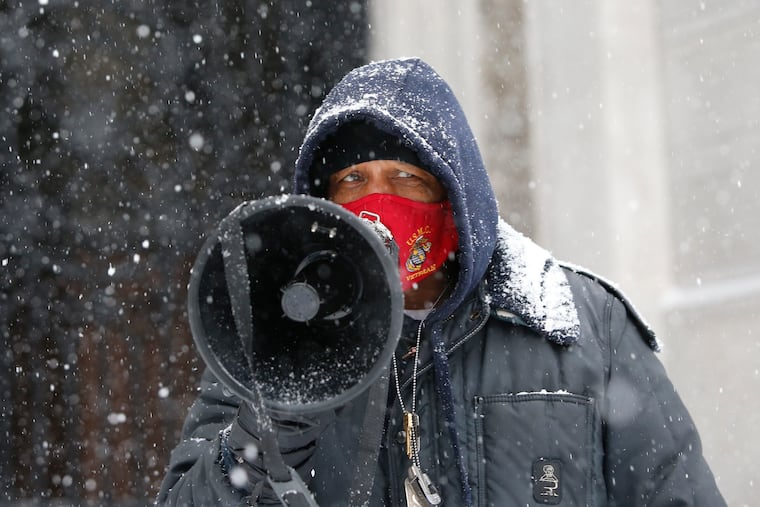One-person protests upend a tired trope that Philadelphia residents don’t care | Helen Ubiñas
Four Philly residents have recently held one-person protests against gun violence. But every day, city residents individually and collectively fight against unchecked violence.

After a 7-year-old was killed while playing on his porch, Darlene Burton, a longtime Kensington resident, stood on a busy Philadelphia intersection last summer with a sign imploring fellow Philadelphians to “Stop Shooting Our Babies.”
Last month, 73-year-old Vietnam veteran Donnie Andrews kicked off his annual 30-day commitment against violence at the corner of Belfield and Wyoming Avenues with his own sign that read: “Murder in Phila. Cain you got to stop killing your brother Abel.”
On Martin Luther King Day, longtime city activist Jamal Johnson, 63, began his one-man hunger strike outside City Hall in hopes that leaders would treat the gun-violence epidemic with the same urgency as the coronavirus pandemic. And specifically, that Mayor Jim Kenney might find his way to talk to him about a September 2020 City Council resolution introduced by Councilmember Jamie Gauthier that would declare gun violence a citywide emergency.
So far, nothing.
“We want the same type of attention that they’re giving to the COVID crisis,” said Johnson. “Hold daily briefings, tell us what’s happening, tell us the strategy, tell us what’s been accomplished. That’s my goal, for him to acknowledge the resolution and tell us what, if anything, he’s going to do about it.”
One night last week, Johnson joined Rosalind Pichardo, who was camping out for peace for a few days in a vacant lot on North 11th Street to call attention to gun violence that has affected too many in her life to count.
No crowds. No hordes of reporters. Just lone citizens doing what officials, trying to cover up their own failures, often imply they aren’t doing: their parts.
These examples might seem as if they reinforce that tired trope. Where are all the people, right? But this is what you see if you aren’t really paying attention, or if you want to reduce residents’ individual and collective efforts.
Every day, Philadelphia residents endure under the weight of gun violence. Last year the city saw nearly 500 homicides, and as of Feb. 2, 50 murders — already more than 30% higher than the same time period in 2020.
Sometimes residents go it alone. Other times they stand together — at rallies and protests and endless hearings and news conferences where city leaders always promise to do more but never quite come through.
“There’s nothing you’re going to name we haven’t done,” said Johnson, who has also walked to D.C. for the last four years to bring awareness to police brutality.
“The people who say nobody cares are the people who don’t care,” Burton said. In addition to her one-woman antiviolence protests, Burton has recently turned her attention to hanging free face masks on a tree outside her home.
Could city residents do more? We all can, but residents might be more inclined if they could trust that they’d be safe when they spoke up, or if dangerous criminals weren’t given reduced sentences only to go on to commit more heinous crimes, or if police solved more than half of the city’s homicides. If the city showed the kind of all-hands-on-deck focus we now know it is capable of. If elected officials, including Mayor Kenney, remembered that they work for city residents, who shouldn’t be ignored.
“Am I seeing that decrease in violence because we’re doing these things?” Pichardo, 43, said. “No, I think now it’s worse than ever. But it’s even more important for us to be persistent, to set an example for each other.”
In the meantime, Andrews recently wrapped up his protest, where for the last 40 years he has written antiviolence messages on a blackboard affixed to a building on the same corner. He recently hung the funeral programs there of young men from the neighborhood who have been picked off one by one by gun violence: Gary Hall Jr. in 2006, Maurice Woods in 2007, Jerome Cox in 2010, Shanik Gantt in 2012, Tyshawn Malik Woods and Demetrius Green in 2020.
Pichardo hits the streets, finding endless ways to try to keep people in Philadelphia from dying from drugs and guns — these days with community kits filled with gun locks, Narcan to reverse overdoses, and bandannas that could be used as face masks and tourniquets.
Burton keeps her mask tree stocked.
Even as he grows weaker from not eating since Jan. 18, Johnson is at City Hall every day.
On Monday, he stood alone, pleading into his megaphone as snow steadily covered everything around him.
“The numbers show we are not doing enough, Mr. Mayor, so come on out. Stop hiding behind COVID-19.”
And Jesus H., Mayor Kenney! Would it kill you to spare a few minutes and come down to speak to Johnson? I’m afraid, weeks into his hunger strike, it might kill him if you don’t.